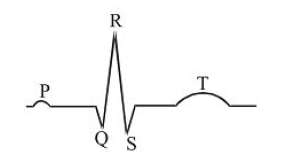The end of T-wave marks the end of
ventricular diastole
ventricular systole
Auricular systole
Auricular diastole
The correct Answer is:D
Step-by-Step Solution:
1. Understanding the T-wave in ECG:
- The T-wave in an electrocardiogram (ECG) represents the process of ventricular repolarization, which is the recovery phase of the ventricles after contraction.
2. Identifying the Phases of the Cardiac Cycle:
- The cardiac cycle consists of two main phases: systole (contraction) and diastole (relaxation).
- Ventricular systole occurs when the ventricles contract to pump blood out of the heart, while ventricular diastole is when the ventricles relax and fill with blood.
3. Connecting T-wave to Ventricular Diastole:
- Since the T-wave indicates the repolarization of the ventricles, it marks the end of the contraction phase (systole) and the beginning of the relaxation phase (diastole).
- Therefore, the end of the T-wave signifies the end of ventricular systole and the commencement of ventricular diastole.
4. Evaluating the Options:
- Option 1: Ventricular diastole - This is the correct answer as it corresponds to the end of the T-wave.
- Option 2: Ventricular systole - Incorrect, as this is represented by the QRS complex.
- Option 3: Auricular systole - Incorrect, as this is represented by the P wave.
- Option 4: Auricular diastole - Incorrect, as this phase does not have a specific wave representation in the ECG.
5. Conclusion:
- The end of the T-wave marks the end of ventricular diastole.
Final Answer:
The end of the T-wave marks the end of ventricular diastole.
---
- The T-wave in an electrocardiogram (ECG) represents the process of ventricular repolarization, which is the recovery phase of the ventricles after contraction.
- The cardiac cycle consists of two main phases: systole (contraction) and diastole (relaxation).
- Ventricular systole occurs when the ventricles contract to pump blood out of the heart, while ventricular diastole is when the ventricles relax and fill with blood.
- Since the T-wave indicates the repolarization of the ventricles, it marks the end of the contraction phase (systole) and the beginning of the relaxation phase (diastole).
- Therefore, the end of the T-wave signifies the end of ventricular systole and the commencement of ventricular diastole.
- Option 1: Ventricular diastole - This is the correct answer as it corresponds to the end of the T-wave.
- Option 2: Ventricular systole - Incorrect, as this is represented by the QRS complex.
- Option 3: Auricular systole - Incorrect, as this is represented by the P wave.
- Option 4: Auricular diastole - Incorrect, as this phase does not have a specific wave representation in the ECG.
- The end of the T-wave marks the end of ventricular diastole.
The end of the T-wave marks the end of ventricular diastole.
Topper's Solved these Questions
Similar Questions
Knowledge Check
- Question 1 - Select One
Go through the following statements
(i) Vagus nerve decreases the rate of impulse formation from the SA node and its conduction
(ii) As the human heart is myogenic in nature, the rate of formation and conduction of cariac impulse cannot be changed by the action of nerves
(iii) The end of T-wave in ECG marks the end of systole.
(iv) If the P-wave in ECG is inverted , it indicates that SA node fails to initiate impulse and the atrial muscle depolarises by the impulse originating in A.V. node.
Whic of these are correct ?A(i),(ii) & (iii)B(i),(iii) & (iv)C(ii),(iii) & (v)DAll are correct - Question 2 - Select One
Read the following statements ( A-C ) about the human heart :
A. The SA node is a specialized mass of cardiac tissue present in the lower-left corner of the right atrium close to the AV septum.
B. The body has the ability to alter the heart rate, cardiac output but not stroke volume.
C. The end of the T- wave in ECG marks the end of the systole.
How Many statements is /are correct from the above?AThreeBTwoCOneDNone - Question 3 - Select One
The end of the T-wave in ECG mark the
Abeginning of Ventricular systoleBend of Ventricular systoleCbeginning of atrial diastoleDend of atrial diastole
In given ECG, end of T-wave marks
 View Solution
View SolutionWhich of the following wave in ECG marks the end of ventricular systole ?
View SolutionThe end of juvenile phase marks the beginning of
View SolutionWhich of the following marks the end of the reproductive phase of a woman's life?
View SolutionWhich of the following marks the end of the reproductive phase of a woman's life?
View Solution

